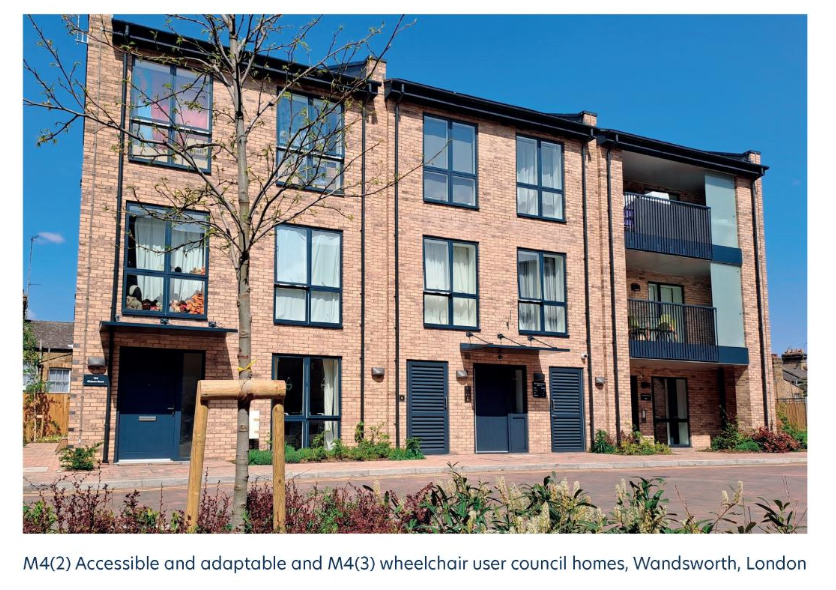To ensure better and more inclusive health outcomes, the TCPA has identified 12 Healthy Homes principles that all new housing developments must provide. Each month, this blog series explores one of the principles
Healthy Homes principle: Inclusive, accessible and adaptable

All new homes should be designed to meet their residents’ diverse and lifelong needs. Housing is a cornerstone for independent living. Yet, the continuing failure to build homes to a suitable standard for people of all ages and abilities is having a devastating impact on people’s physical and mental health.
There are currently 104,000 disabled people on councils’ waiting lists for accessible and adaptable homes (Inclusion London, campaign notes), and despite an increasingly aging population and 11.6 million disabled people in England, 91% of the existing housing stock does not provide the most basic accessibility features (HoME Coalition). For 400,000 wheelchair users in England, their ability to use facilities such as the bathroom or the kitchen, or to get in and out independently, is greatly limited by the inaccessible characteristics of their homes (Inclusion London, campaign notes).
‘My accessible home improves my quality of life. My accessible home gives me peace of mind. My accessible home gives me the freedom that many don’t have.‘ – Adam Gabsi, Inclusion London
Why is there a lack of accessible housing?
The lack of accessible housing is explained by two factors. The first issue is an older housing stock that was not built to accessible standards and can be difficult to adapt. The second cause is developers building new homes that do not meet the building regulation M4(2) ‘accessible and adaptable’ standard.
The M4(2) standard, also known as ‘lifetime’ housing, goes beyond the current M4(1) ‘visitable’ baseline. It ensures step-free access to the main entrance, more space in all areas of the home to make moving around easier, and easily adaptable features to improve accessibility as needed. Developers can argue that building to a higher accessibility standard is more expensive (estimated at an additional £1,387 per dwelling) (Centre for Ageing Better, 2020) and therefore less profitable, challenging local authorities in their need for more accessible housing.
However, such appraisals miss the social value of providing accessible housing designed to meet people’s needs. The cost of poor housing to the NHS for households headed by individuals aged 55 and over skyrockets to £513 million, £177 million of which comes from people falling in their homes (Centre for Ageing Better, 2020). A report commissioned by Homes England notably found that investment in ‘Extra Care housing’ or housing-with-care would generate a healthcare system financial saving of £1,840 per person per year.
Accessibility in homes from permitted development rights
The ongoing housing crisis is exacerbating the inadequate provision of inclusive homes, as the challenge of delivering more homes has sidelined the question of the quality of those homes. Since 2013, deregulation of the planning system has led to an increase in permitted development rights (PDR) conversions, allowing offices and light industrial warehouses to be turned into housing without full planning requirements. Building regulations on inclusion and accessibility (approved documents M) do not clearly apply to dwellings produced through ‘material change of use’ such as PDR homes (TCPA, 2024). This again leads to a failure to meet the demand for more accessible and adaptable homes, and to ensure a resilient housing stock that meets the needs of all its residents.


Inclusion London – Accessible Housing Campaign
On 29 July, Inclusion London, a charity that supports over 70 Deaf and Disabled organisations across London, protested on Parliament Square as part of its Accessible Housing Campaign. This action comes exactly two years after the previous government promised to raise minimum standards for new build homes, which they have since then failed to deliver on. In a letter, Inclusion London is asking the new government to:
- ‘Make the M4(2) ‘accessible and adaptable’ standard the minimum requirement for all new build homes, as the previous Government committed to on 29 July 2022
- Set a minimum target of 10% of new build homes to meet the M4(3) wheelchair user standard
- Ensure that the majority of accessible homes are built in the social rented sector, as more disabled people need these kind of homes’ (Inclusion London, 2024)
Indeed, given that disabled individuals are more likely to have lower incomes or be unemployed compared to non-disabled people, they often depend more on social housing, especially as accessible housing is often unaffordable.
Unfortunately, there are social landlords and associations who continue the systemic discrimination that makes life even harder for disabled people, ignoring key aspects of the Equality Act 2010 that relate to disability. By attributing difficult and anti-social behaviours to residents with mental health disabilities or neurodivergent behavioural traits, they fail to make the necessary adjustments to properties and procedures, exacerbating the precarity of their most vulnerable tenants (SHAC, 2021).
In view of this underlying prejudice, SHAC (Social Housing Action Campaign) has developed a Social Landlord Disability Charter Scheme in order ‘to encourage and help housing associations to achieve greater awareness and compliance with the disabilities aspect of the Equality Act 2010’ (SHAC, 2021).
‘To us affordability and accessibility is one and the same’ – campaigner at Inclusion London protest
Frustration has grown over the lack of action in recent years. Adam Gabsi, Co-Chair of Inclusion London, shared this sentiment, “I can’t even see the barriers, that’s the issue.” Speakers at the protest agreed that the extent of necessary change requires policy and cooperative efforts, acknowledging that it is a fundamental right for everyone to live in a home that meets their needs.
Inclusive Housing Design Guide
There is growing understanding and good practice about building homes and wider neighbourhoods that are more inclusive and adaptable, for all ages and needs of residents. The latest Inclusive Housing Design Guide (RIBA and HabInteg, 2024), authored by housing occupational therapist and inclusive design specialist – Jacquel Runnalls, and lead peer reviewer Marney Walker also a housing occupational therapist – provides practical insights and examples. The guide demonstrates how inclusive housing can be designed and delivered at minimal or no additional cost – if considered from the outset and can in fact provide potential significant resource savings, exponential benefits, and ultimately homes that are fit for purpose and enable as many people as possible to live fulfilled lives throughout their lifetime.

Image: from The Inclusive Housing Design Guide (2024)
HoME coalition
The HoME (Housing Made for Everyone) coalition, founded by nine charities and housing organisations, including Centre for Ageing Better, Habinteg, HousingLin, and TCPA, have been calling for more accessible and adaptable homes. Through initiatives such as the Campaign for Healthy Homes (TCPA), HousingLin’s accessibility and adaptability resources, and Homes for all ages (Centre for Ageing Better), the coalition are advocating for immediate action to address the severe shortage of accessible housing and to establish accessibility as a foundational standard in new home development.
Ensuring all new homes are inclusive, accessible and adaptable is one of the 12 core principles of the Healthy Homes Campaign. You can support this principle by signing the Healthy Homes Pledge.
Clémence Dye – Projects and policy assistant, TCPA and Rosalie Callway – Project and Policy manager, TCPA



